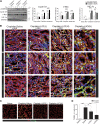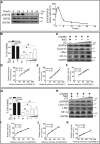Delayed administration of a single dose of lithium promotes recovery from AKI
- PMID: 24408869
- PMCID: PMC3935583
- DOI: 10.1681/ASN.2013040350
Delayed administration of a single dose of lithium promotes recovery from AKI
Abstract
Evidence suggests that glycogen synthase kinase 3β (GSK3β) contributes to AKI; however, its role in post-AKI kidney repair remains uncertain. Here, delayed treatment with a single dose of lithium, a selective inhibitor of GSK3β and a US Food and Drug Administration-approved mood stabilizer, accelerated recovery of renal function, promoted repopulation of renal tubular epithelia, and improved kidney repair in murine models of cisplatin- and ischemia/reperfusion-induced AKI. These effects associated with reduced GSK3β activity and elevated expression of proproliferative molecules, including cyclin D1, c-Myc, and hypoxia-inducible factor 1α (HIF-1α), in renal tubular epithelia. In cultured renal tubular cells, cisplatin exposure led to transient repression of GSK3β activity followed by a prolonged upregulation of activity. Rescue treatment with lithium inhibited GSK3β activity, enhanced nuclear expression of cyclin D1, c-Myc, and HIF-1α, and boosted cellular proliferation. Similarly, ectopic expression of a kinase-dead mutant of GSK3β enhanced the expression of cyclin D1, c-Myc, and HIF-1α and amplified cellular proliferation after cisplatin injury, whereas forced expression of a constitutively active mutant of GSK3β abrogated the effects of lithium. Mechanistically, GSK3β colocalized and physically interacted with cyclin D1, c-Myc, and HIF-1α in tubular cells. In silico analysis revealed that cyclin D1, c-Myc, and HIF-1α harbor putative GSK3β consensus phosphorylation motifs, implying GSK3β-directed phosphorylation and subsequent degradation of these molecules. Notably, cotreatment with lithium enhanced the proapoptotic effects of cisplatin in cultured colon cancer cells. Collectively, our findings suggest that pharmacologic targeting of GSK3β by lithium may be a novel therapeutic strategy to improve renal salvage after AKI.
Figures







Comment in
-
Lithium in kidney diseases: big roles for the smallest metal.J Am Soc Nephrol. 2014 Mar;25(3):421-3. doi: 10.1681/ASN.2013111216. Epub 2014 Jan 9. J Am Soc Nephrol. 2014. PMID: 24408870 Free PMC article. No abstract available.
-
Basic research: the long and the short of it-the temporal effects of renal lithium exposure are beginning to be unravelled.Nat Rev Nephrol. 2014 Mar;10(3):123. doi: 10.1038/nrneph.2014.10. Epub 2014 Jan 28. Nat Rev Nephrol. 2014. PMID: 24468767 No abstract available.
Similar articles
-
Glycogen synthase kinase-3β inhibits tubular regeneration in acute kidney injury by a FoxM1-dependent mechanism.FASEB J. 2020 Oct;34(10):13597-13608. doi: 10.1096/fj.202000526RR. Epub 2020 Aug 19. FASEB J. 2020. PMID: 32813289 Free PMC article.
-
GSK3β-mediated Keap1-independent regulation of Nrf2 antioxidant response: A molecular rheostat of acute kidney injury to chronic kidney disease transition.Redox Biol. 2019 Sep;26:101275. doi: 10.1016/j.redox.2019.101275. Epub 2019 Jul 17. Redox Biol. 2019. PMID: 31349118 Free PMC article.
-
Redox-sensitive glycogen synthase kinase 3β-directed control of mitochondrial permeability transition: rheostatic regulation of acute kidney injury.Free Radic Biol Med. 2013 Dec;65:849-858. doi: 10.1016/j.freeradbiomed.2013.08.169. Epub 2013 Aug 22. Free Radic Biol Med. 2013. PMID: 23973862 Free PMC article.
-
Remote ischemic preconditioning for kidney protection: GSK3β-centric insights into the mechanism of action.Am J Kidney Dis. 2015 Nov;66(5):846-56. doi: 10.1053/j.ajkd.2015.06.026. Epub 2015 Aug 10. Am J Kidney Dis. 2015. PMID: 26271146 Free PMC article. Review.
-
Glycogen Synthase Kinase-3 Signaling in Acute Kidney Injury.Nephron. 2020;144(12):609-612. doi: 10.1159/000509354. Epub 2020 Jul 29. Nephron. 2020. PMID: 32726778 Free PMC article. Review.
Cited by
-
Administration of a single dose of lithium ameliorates rhabdomyolysis-associated acute kidney injury in rats.PLoS One. 2023 Feb 16;18(2):e0281679. doi: 10.1371/journal.pone.0281679. eCollection 2023. PLoS One. 2023. PMID: 36795689 Free PMC article.
-
Risk for Chronic Kidney Disease Progression After Acute Kidney Injury: Findings From the Chronic Renal Insufficiency Cohort Study.Ann Intern Med. 2023 Jul;176(7):961-968. doi: 10.7326/M22-3617. Epub 2023 Jul 11. Ann Intern Med. 2023. PMID: 37429030 Free PMC article.
-
Lithium reduces blood glucose levels, but aggravates albuminuria in BTBR-ob/ob mice.PLoS One. 2017 Dec 15;12(12):e0189485. doi: 10.1371/journal.pone.0189485. eCollection 2017. PLoS One. 2017. PMID: 29244860 Free PMC article.
-
Glycogen synthase kinase-3β inhibits tubular regeneration in acute kidney injury by a FoxM1-dependent mechanism.FASEB J. 2020 Oct;34(10):13597-13608. doi: 10.1096/fj.202000526RR. Epub 2020 Aug 19. FASEB J. 2020. PMID: 32813289 Free PMC article.
-
GSK3β-mediated Keap1-independent regulation of Nrf2 antioxidant response: A molecular rheostat of acute kidney injury to chronic kidney disease transition.Redox Biol. 2019 Sep;26:101275. doi: 10.1016/j.redox.2019.101275. Epub 2019 Jul 17. Redox Biol. 2019. PMID: 31349118 Free PMC article.
References
-
- Humphreys BD, Valerius MT, Kobayashi A, Mugford JW, Soeung S, Duffield JS, McMahon AP, Bonventre JV: Intrinsic epithelial cells repair the kidney after injury. Cell Stem Cell 2: 284–291, 2008 - PubMed
-
- Witzgall R, Brown D, Schwarz C, Bonventre JV: Localization of proliferating cell nuclear antigen, vimentin, c-Fos, and clusterin in the postischemic kidney. Evidence for a heterogenous genetic response among nephron segments, and a large pool of mitotically active and dedifferentiated cells. J Clin Invest 93: 2175–2188, 1994 - PMC - PubMed
-
- Yang L, Humphreys BD, Bonventre JV: Pathophysiology of acute kidney injury to chronic kidney disease: Maladaptive repair. Contrib Nephrol 174: 149–155, 2011 - PubMed
Publication types
MeSH terms
Substances
Grants and funding
LinkOut - more resources
Full Text Sources
Other Literature Sources
Medical
Research Materials

